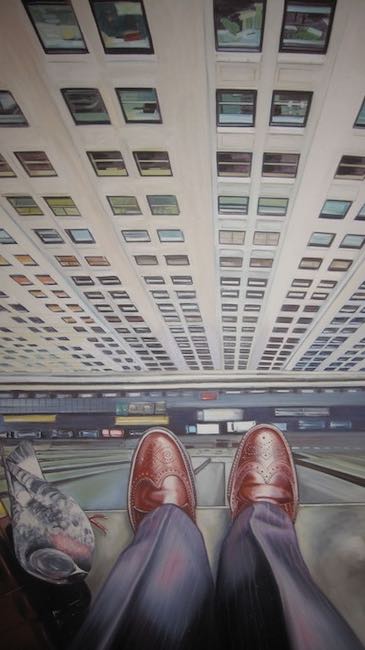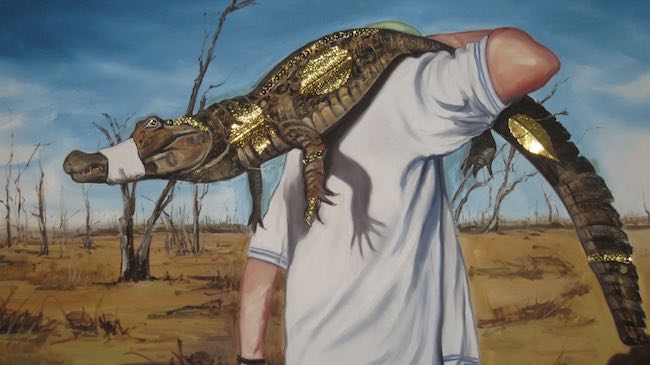Osservare tutto ciò che circonda la quotidianità fa parte dell’arte in sé, in particolar modo del periodo contemporaneo in cui il creativo ha bisogno di interrogarsi, esprimersi, ascoltarsi e interpretare quanto inevitabilmente contraddistingue il vivere attuale e che si manifesta nella ripetitività della routine, almeno fino a quando, appunto, tutto non viene narrato con uno sguardo nuovo, critico ma anche analitico. L’approccio pittorico può variare sulla base della scelta personale di ciascun artista, dunque dalla completa e totale indefinitezza si può passare alla più precisa riproduzione della realtà, ma in ogni caso il lavoro espressivo di ciascuno apre uno spiraglio su un’attualità che mai come nel presente ha bisogno di essere filtrata e soggettivizzata. La protagonista di oggi si esprime attraverso uno stile chiaro, manifesto dal punto di vista figurativo, ma poi si sposta a volta sul mondo metaforico altre invece su quello più simbolico per indurre l’osservatore ad approfondire i temi che affronta.
Laddove la prima metà del Novecento fu dominata dalla tendenza di molti movimenti artistici a distaccarsi dall’immagine conosciuta per affrontare il tema della superiorità, della predominanza del gesto plastico su qualsiasi forma figurativa perché l’abilità, la maestria dell’esecutore dell’opera doveva essere riscontrabile anche quando l’occhio non poteva cogliere particolari già conosciuti, dall’altra vi furono correnti che invece proprio attraverso la riproduzione di ciò a cui lo sguardo era abituato volevano condurre la mente verso significati differenti da quelli immaginati, portare il fruitore nel mondo dell’inconscio, dell’enigma, dell’inquietudine che necessitava di emergere in un periodo, quello a cavallo tra le due guerre, dove la società era stata completamente stravolta dalle distruzioni e dalle violenze e la vita aveva assunto un significato nuovo, più intenso, più attento a tutto quel lato troppo spesso lasciato inascoltato ma che in realtà ne diveniva essenza e linfa vitale. Gli istinti primordiali di Salvador Dalì svelarono la necessità di porsi in posizione di ascolto delle proprie pulsioni e ossessioni, come il sesso, il tempo, l’alienazione, per dare alla pittura e all’arte il compito di liberare l’individuo dai limiti imposti dalla ragione, così come gli enigmi e le sottili riflessioni delle opere apparentemente leggere eppure incredibilmente profonde di René Magritte avevano la funzione di indurre il fruitore ad andare oltre, a intravedere una realtà diversa, sottile eppure tanto possibile quanto quella più superficialmente evidente. Questa tendenza alla figurazione continuò il suo cammino ed ebbe la sua massima manifestazione intorno alla metà degli anni Cinquanta, prima con il Realismo Americano e poi con la sua esaltazione ed estremizzazione nell’Iperrealismo dove la fedeltà fotografica di Richard Estes, Ralph Goings e Chuck Close spesso si avvicinava al mondo della Metafisica per la tendenza a evidenziare un dettaglio, che poteva divenire spunto di riflessione sul mondo consumistico statunitense, sulle abitudini della nuova classe media emergente e sulla bellezza patinata delle metropoli che divenivano specchio del benessere di quegli anni, di un’evoluzione tecnologica e abitativa a cui l’essere umano si abituava per necessità pur non nascondendo di sentirsi in qualche modo omologato, alienato da tanto progresso.

L’artista austriaca Jutta Wenth, in arte Krekerella, mescola sapientemente questi due stili, il Surrealismo e l’Iperrealismo, per dar vita a un linguaggio pittorico che da un lato si attiene fortemente all’osservato ma dall’altro pervade le sue tele di significati a volte più espliciti, altre più sottili e altre ancora simbolici per spingere il fruitore verso una riflessione nei confronti di tutto ciò che appare come un’abitudine acquisita pur potendo essere vista attraverso un’altra lente, meno superficiale, più orientata a cercare un senso vero e concreto nell’effimero che spesso contraddistingue la vita attuale.

L’olio su tela è la tecnica di cui si avvale e che le consente di riprodurre il dettaglio, lo scorcio che ha catturato il suo intuito creativo e che poi ha stimolato in lei il desiderio di mostrare quel lato più sottile della realtà, abitualmente intravedibile da chi ha una sviluppata sensibilità e forse anche per questo predisposto a mettere in luce questioni, aspetti, troppo spesso trascurati in una contemporaneità in cui le persone sono distratte, assuefatte ad abitudini e modi di fare impedendosi così di mantenere una propria individualità.

La gamma cromatica che contraddistingue le opere di Jutta Wenth è intensa e arricchita di una luminosità e di un contrasto tra luce e ombra che sfiora il Fotorealismo seppure subito dopo che l’occhio è stato conquistato dall’armonia estetica dei dipinti è indotto a vagare alla ricerca del significato che si nasconde dietro l’immagine e che l’artista sapientemente nasconde in modo tale stimolare chi guarda a farsi domande; in altre tele invece il messaggio è più chiaro, palese pur tuttavia celando altro, un pensiero, una considerazione, un frammento vissuto e che ha bisogno di essere comunicato.

È esattamente questo che emerge dall’opera Mrs. Liberty, un autoritratto in cui la Wenth pone se stessa sotto il simbolo per eccellenza della libertà ma anche della capacità di realizzare un sogno, di ottenere ciò che ci si è prefissati, come i primi coloni inglesi che giungendo a Ellis Island hanno immaginato di costruire un nuovo grande paese. Tanto quanto l’artista sogna di affermarsi nella Grande Mela; e dunque quale miglior auspicio per sé se non quello di avere la medesima determinazione dei fondatori degli Stati Uniti nel perseguire il suo progetto di essere conosciuta anche oltreoceano?

Il dipinto Do you really want to hurt me? è invece molto più surrealista, racconta del dolore inteso anche come violenza che spesso le donne subiscono senza essere in grado di difendersi, un po’ per mancanza di coraggio, un po’ per paura di essere loro stesse la vera causa delle ire e della disapprovazione di chi sta loro intorno, e un po’ per amore, perché molto più frequentemente di quanto si pensi si confonde la violenza con attenzione da parte dell’altro. Nella composizione la donna è al centro, colpita, frastagliata perché privata della propria essenza e voglia di vivere, osservata con invidia, sentimento quest’ultimo considerabile come forma di violenza, aggredita persino da personaggi dei fumetti proprio per sottolineare quanto sia fragile l’equilibrio che la figura femminile è chiamata a mantenere per non perdere se stessa lasciandosi sopraffare dall’esterno.

E ancora la tela To be or not to be Jutta Wenth mostra tutta l’alienazione dell’uomo contemporaneo immortalando l’attimo di una scelta definitiva, quel continuare a essere, a esistere, malgrado la solitudine e il vuoto che si possa provare anche laddove circondati da una moltitudine, oppure mettere fine alla propria vita scegliendo di lasciarsi precipitare da un’altezza troppo grande per poter sperare di salvarsi; eppure accanto ai piedi dell’uomo l’autrice pone un piccione, come se in qualche modo volesse indicare che esiste un’altra versione della storia, che il tentativo dell’individuo sia quello di riuscire a volare, metafora in fondo della temerarietà di uscire dalle abitudini, da un destino che sembra segnato e a cui le persone tendono ad abituarsi senza neanche prendere in considerazione la possibilità di cambiarlo. Ecco dunque che il piccione diviene simbolo della capacità di trovare il coraggio di fare un salto nel buio che anziché determinare un peggioramento, un pericolo, si trasforma nella migliore delle opzioni possibili.

Jutta Wenth si diletta anche con la tecnica ad acrilico, oltre all’acquarello, il pastello, il carboncino, perché la sperimentazione artistica fa parte della sua stessa essenza, ed è esattamente in questa tecnica che rende omaggio a uno dei maestri del Surrealismo, Salvador Dalì, che immortala con una rosa alla fine di un baffo e la sua tipica espressione inquietante e inquieta che riassume il suo animo tormentato di genio folle dell’arte moderna. Jutta Wenth ha alle spalle quarantatre anni di carriera artistica durante i quali ha esposto in centocinque mostre in Austria e all’estero, tra personali e collettive, è pubblicata in numerose riviste e annuari d’arte e vanta collezionisti in Germania, Italia, Cina, Florida e Canada. Le sue opere fanno parte di collezioni pubbliche come la Montanuniversität Leoben, la Landhaus Lisl Wagner-Bacher nella Wachau, e ha ricevuto commissioni per eseguire ritratti da personaggi noti a livello internazionali.
JUTTA WENTH-CONTATTI
Email: jutta.wenth.art@gmail.com
Sito web: www.juttawenth.at
The atypical visions of Jutta Wenth, between Hyperrealism and Surrealism to explore the manifold possibilities of existence
Observing everything that surrounds the everyday is part of art in itself, especially in the contemporary period in which the creative person needs to question, express, listen to himself and interpret what inevitably characterises present-day living and which manifests itself in the repetitiveness of routine, at least until, precisely, everything is narrated with a new, critical but also analytical gaze. The pictorial approach can vary on the basis of each artist’s personal choice, so from complete and total indefiniteness one can move on to the most precise reproduction of reality, but in any case the expressive work of each one opens a glimmer on a topicality that never needs to be filtered and subjectivised as in the present. Today’s protagonist expresses herself through a clear style, manifest from a figurative point of view, but then moves sometimes to the metaphorical world, sometimes to the more symbolic one, in order to induce the observer to delve deeper into the themes she deals with.
While the first half of the 20th century was dominated by the tendency of many artistic movements to detach themselves from the known image in order to address the theme of superiority, of the predominance of the plastic gesture over any figurative form because the skill, the mastery of the work’s executor had to be discernible even when the eye could not grasp details already known, on the other hand, there were currents that, precisely through the reproduction of what the eye was accustomed to, wanted to lead the mind towards meanings different from those imagined, to take the viewer into the world of the unconscious, of the enigma, of the restlessness that needed to emerge in a period, the one between the two wars, where society had been completely overturned by destruction and violence and life had taken on a new, more intense meaning, more attentive to all that side that was too often left unheard but which in reality became its essence and lifeblood. Salvador Dali’s primordial instincts revealed the need to place in a position of listening to one’s own drives and obsessions, such as sex, time, alienation, in order to give painting and art the task of freeing the individual from the limits imposed by reason, just as the enigmas and subtle reflections of René Magritte’s apparently light yet incredibly profound artworks had the function of inducing the viewer to go further, to glimpse a different reality, subtle yet as possible as that which is most superficially evident.
This tendency towards figuration continued on its way and had its greatest manifestation around the mid-1950s, first with American Realism and then with its exaltation and extremisation in Hyperrealism where the photographic fidelity of Richard Estes, Ralph Goings and Chuck Close often approached the world of Metaphysics through the tendency to highlight a detail which could become food for thought on the American consumerist world, on the habits of the new emerging middle class and on the glossy beauty of the metropolises that became mirrors of the welfare of those years, of a technological and housing evolution to which the human being became accustomed out of necessity while not hiding the fact that he felt somehow homologated, alienated by so much progress. The Austrian artist Jutta Wenth, aka Krekerella, skilfully mixes these two styles, Surrealism and Hyperrealism, to give life to a pictorial language that on the one hand strongly adheres to the observed but on the other pervades her canvases with meanings that are at times more explicit others more subtle and still others symbolic to push the viewer towards a reflection on everything that appears to be an acquired habit even though it can be seen through another lens, less superficial, more oriented towards searching for a true and concrete meaning in the ephemeral that often characterises current life. Oil on canvas is the technique that she uses and that allows her to reproduce the detail, the glimpse that captured her creative intuition and that then stimulated in her the desire to show that more subtle side of reality, usually glimpsed by those with a developed sensitivity and perhaps also for this reason predisposed to highlight issues, aspects, too often neglected in a contemporaneity in which people are distracted, addicted to habits and ways of doing things, thus preventing them from maintaining their own individuality.
The chromatic range that distinguishes Jutta Wenth’s artworks is intense and enriched with a luminosity and contrast between light and shadow that verges on Photorealism, even though immediately after the eye is won over by the aesthetic harmony of the paintings, it is induced to wander in search of the meaning hidden behind the image and which the artist skilfully conceals in such a way as to stimulate the beholder to ask himself questions; in other canvases, on the other hand, the message is clearer, overt yet concealing something else, a thought, a consideration, an experienced fragment that needs to be communicated. This is exactly what emerges from the artwork Mrs. Liberty, a self-portrait in which Wenth places herself under the symbol par excellence of freedom but also of the ability to realise a dream, to achieve what one has set oneself, like the first English settlers who, on arriving at Ellis Island, imagined to build a great new country. As much as the artist dreams of establishing herself in the Big Apple; and so what better wish for herself than to have the same determination as the founders of the United States in pursuing her project of being known overseas? The painting Do you really want to hurt me? is instead much more surrealist, telling of the pain also understood as violence that women often suffer without being able to defend themselves, partly for lack of courage, partly out of fear of being themselves the true cause of the wrath and disapproval of those around them, and partly out of love, because much more frequently than one thinks, violence is confused with attention from the other. In the composition, the woman is at the centre, struck, jagged because she is deprived of her own essence and will to live, observed with envy, a sentiment that can be considered as a form of violence, even attacked by comic book characters precisely to emphasise how fragile the balance that the female figure is called upon to maintain in order not to lose herself by letting be overwhelmed by the outside world.
And again, in the canvas To be or not to be, Jutta Wenth shows all the alienation of contemporary man, immortalising the moment of a definitive choice, that of continuing to be, to exist, despite the loneliness and emptiness that one can feel even when surrounded by a multitude, or putting an end to one’s life by choosing to let oneself fall from a height too great to be able to hope to save oneself; yet next to the feet of the man, the author places a pigeon, as if somehow wanting to indicate that there is another version of the story, that the individual’s attempt is to succeed in flying, a metaphor in the end for the temerity of breaking out of habits, out of a destiny that seems marked out and to which people tend to get used without even considering the possibility of changing it. Here, then, the pigeon becomes a symbol of the ability to find the courage to take a leap in the dark that, instead of bringing about a worsening, a danger, turns into the best possible option. Jutta Wenth also dabbles in the acrylic technique, as well as watercolour, pastel and charcoal, because artistic experimentation is part of her very essence, and it is precisely in this technique that she pays homage to one of the masters of Surrealism, Salvador Dali, whom she immortalises with a rose at the edge of a mustache and his typical disquieting and restless expression that sums up his tormented soul as the mad genius of modern art. Jutta Wenth has a forty-three year artistic career, during which she has had one hundred and five solo and group exhibitions in Austria and abroad, has been published in numerous art magazines and yearbooks, and has collectors in Germany, Italy, China, Florida and Canada. Her artworks are part of public collections such as the Montanuniversität Leoben, the Landhaus Lisl Wagner-Bacher in the Wachau, and she has received portrait commissions from internationally renowned personalities.














